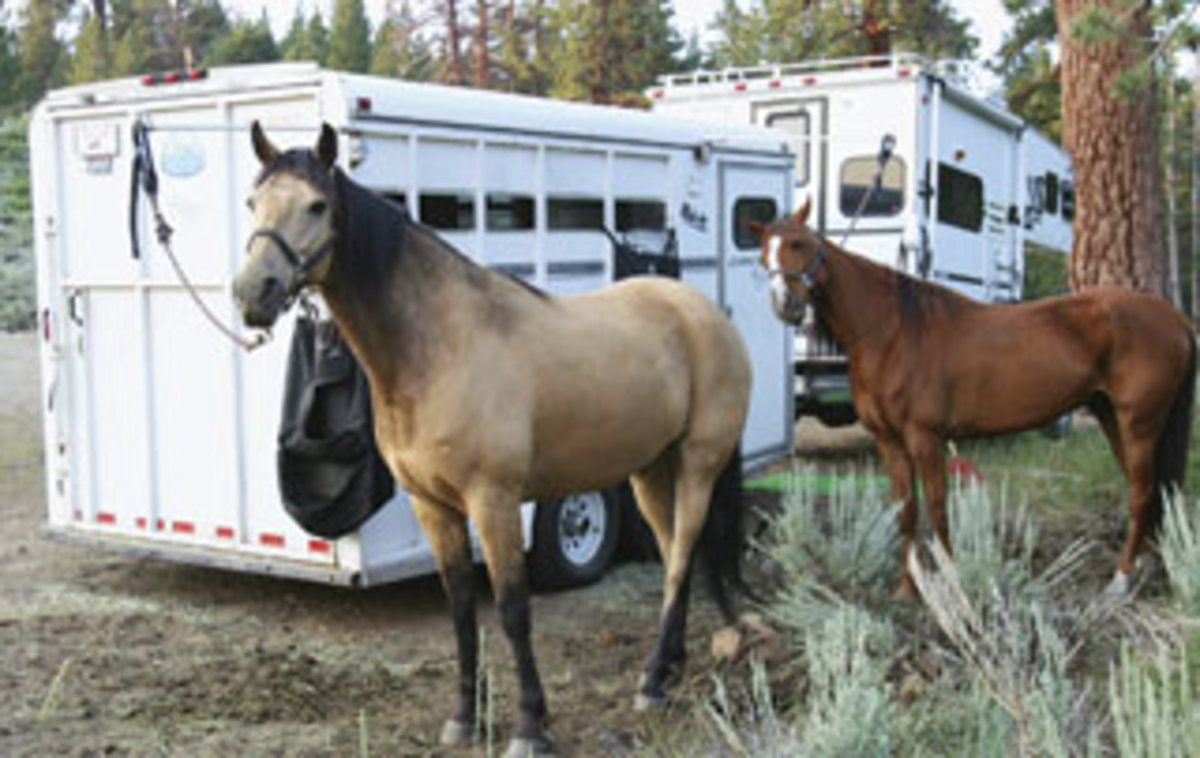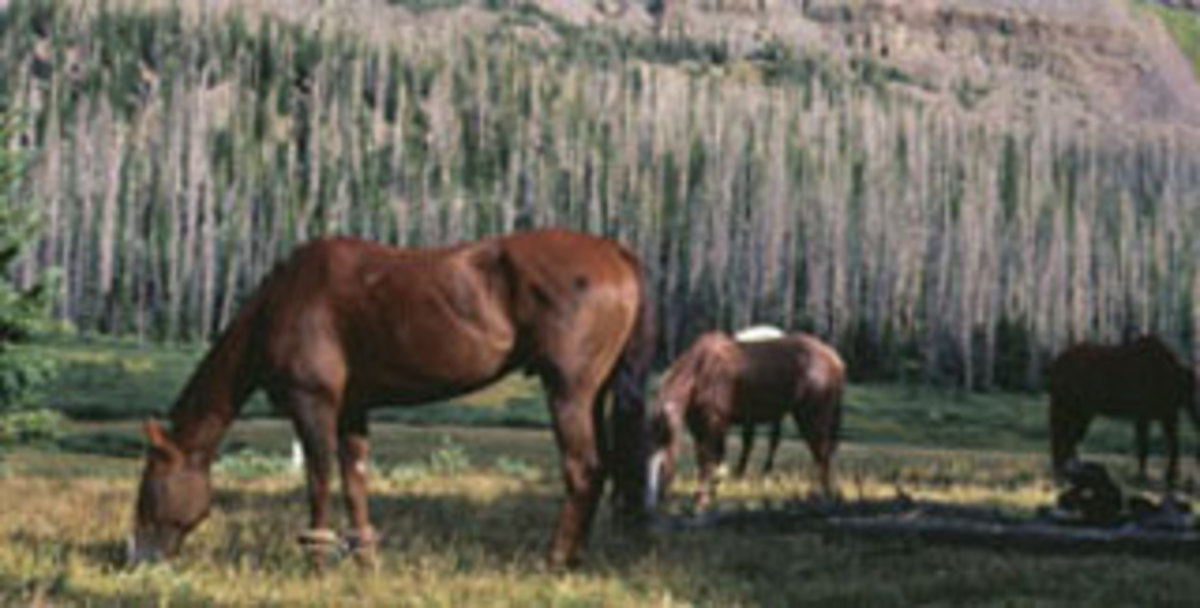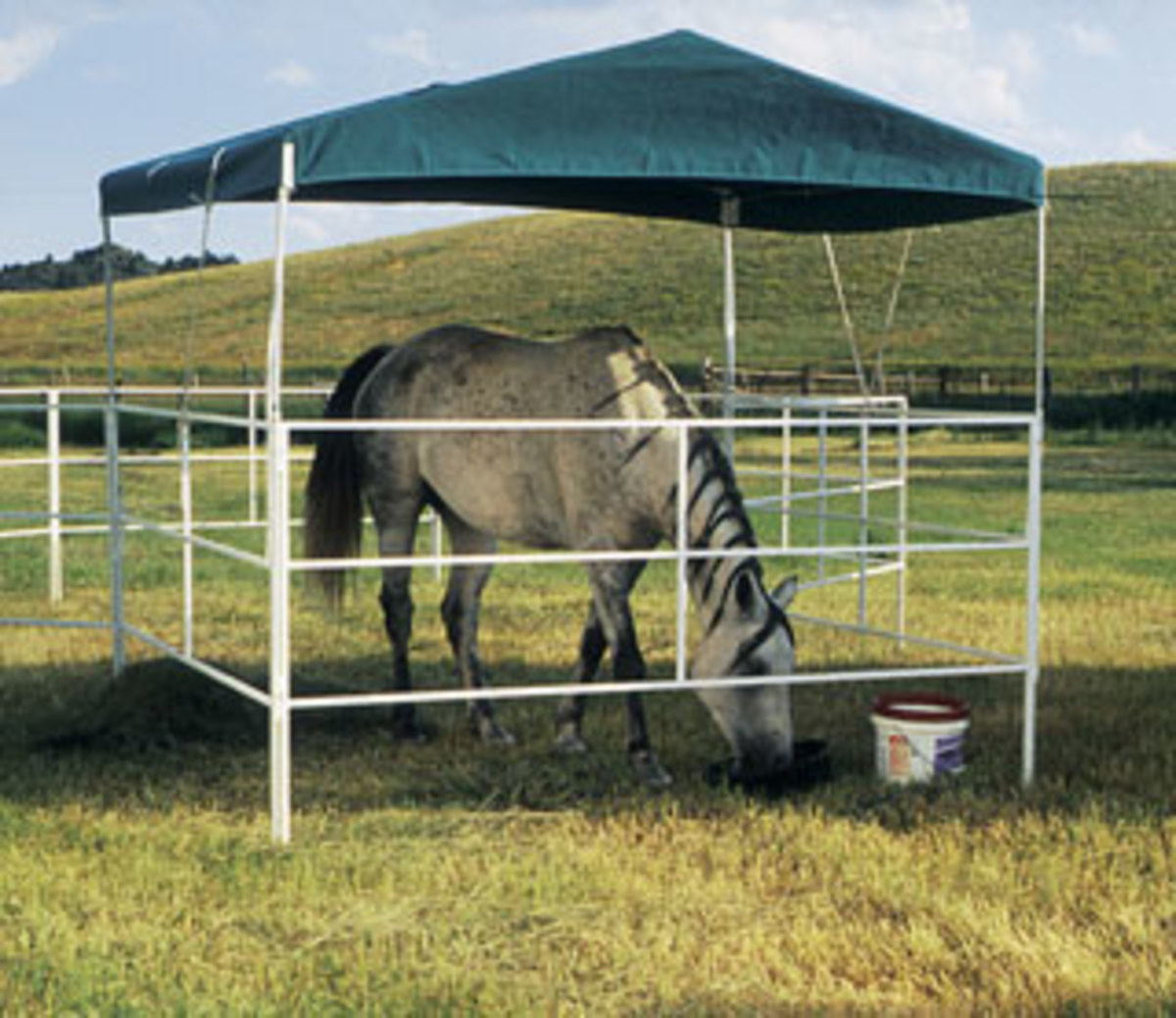One outstanding luxury afforded by our country is the abundance of public lands available to trail riding. You can explore the wilderness any time of year. You might go on organized day rides or overnight camping trips where large groups of horses congregate. While these activities are enjoyable, they provide ample opportunities for losing your horse on the trail or from your campsite.
My husband and I once spent two months riding our horses across Colorado. During that adventure, we learned about keeping our horses in view while they were hobbled around our camp. Some lessons were learned the hard way, accompanied by time spent tracking and hiking. We always recovered our horses within five hours, but other folks haven’t been as lucky. They’ve lost their horses for days, weeks, and months; some have never been found. Here, we’ll look at ways to help prevent your horse from getting loose, and what to do if he gets out of sight, or worse, is stolen.

Here are some ways to keep a firm grip on your horse on the trail and in camp. (Caveat: Before you leave home, accustom your horse to any containment techniques you plan to use on the trail and/or while camping; if you need to, ask a knowledgeable horseperson to help you.)
Ride with others. If your horse spooks or bolts, you may be forced to let go of the reins as you fall. Then you’ve got a horse on the loose. Ride with at least one other person in case you do get thrown, not only for your own safety but also to enable quick recovery of your horse. Being a herd animal, your horse will tend to stay with the other horse or horses, and will be less likely to run off. And, if he does, your riding buddy can follow him on horseback to catch him.
Tether your packhorse. On a pack trip, it can be tempting to let the packhorses follow the saddle horses without a lead rope. This often works well, but not always. If there’s more than one pack-horse loose on the trail, they might venture off on their own, content with each other’s company, but separated from the group. Tether each packhorse to another horse, or lead him from a cooperative saddle horse.
Tie securely. Part of the wilderness experience means pausing on the trail to enjoy the view, eat lunch, go fishing, or explore steep terrain on foot. During such saddle breaks, tie your horse securely using a halter and lead rope to a strong tree. Make sure he can’t get tangled in the branches with his lead rope, or catch his leg in it.
Use a breakable halter. Use a leather or Breakaway halter in case your horse does break loose. Halters made from rope or nylon won’t give under pressure when snagged on a solid object; the result could be disastrous.
Use a highline. In camp, an excellent method of securing your horses is with a highline. To set up a highline, secure a stout rope between two strong trees, or between two horse trailers or a combination of tree and trailer. Find a location with relatively level, solid footing, free of natural hazards. Separate each horse by about 12 to 15 feet, or whatever distance is necessary to prevent kicking or entanglement. Tie each lead line to the highline so that no horse can get his head much lower than his chest. When you’re nearby to monitor the horses, you can lengthen the line to release their heads so their noses just barely reach the ground; then they can graze or lie down. But never leave a horse unattended on a long line.
Use a picket line. This is another useful restraint option that allows your horse to graze. Se cure one end of a 30-foot length of rope to a stake hammered deeply into the ground or tied to the base of a big tree. (Drive it straight in for optimal security.) Attach the other end to a single hobble on your horse’s leg. Your horse can then walk in a large diameter to graze and lie down.
Check your horse often to make sure he doesn’t wrap the line around the tree base, shortening the tether. Don’t picket to a downed tree or log as a strong horse can run with these in tow, which not only is frightening, but also potentially disastrous.

Use hobbles.Hobbling allows your horse to graze on available pasture. A downside: A hobbled horse is still fairly mobile. Stagger the hobbled horses to reduce the risk of losing the whole group. Secure one or more dominant mounts while the others feed to encourage the herd to stay together. Bell the secured horse so the others will know where he is, especially at night, and so you can audibly track his presence.

Use portable corral panels. If you’re camped next to your rig, you can set up portable corral panels that safely enclose your horse, giving you peace of mind. Double check all gates and clips to prevent your bored horse from escaping.
Don’t rely on electric fencing. Don’t rely on an electric fence enclosure; a horse can easily run through it. A “hot” fence deters a horse from getting near it, but when he does, it’s hardly a barrier for a 1000-pound animal with a startle-and-flight reflex.
I once had an unpleasant experience related to electric fencing on a 100-mile, 24-hour endurance ride I vetted. It was4 a.m., and the last horse in the competition had just finished. Someone volunteered to drive me to the bunkhouse for much-needed sleep. As we made our way up the hill, a horse suddenly appeared out of the deep, black night, running at full gallop toward the car. Our headlights lit him up like an apparition.
He flew by, just missing our car, but a second horse, close behind, wasn’t so lucky. He tried to leap the car, but couldn’t. He landed directly on the windshield in front of me, our eyes locking before impact. The safety glass held, and he bounced off the car and vanished into the night, leaving the driver screaming in her seat and me wondrous at having escaped near death. Fortunately, he was later found with only a few bruises and scrapes; he’d gone back to the endurance trail he’d just left, a good five miles away.
Later, we found out that the two horses were enclosed in the same electric-fence paddock. When one horse got up from a roll, he hit the fence wire, and he and his companion spooked and bolted into the night.
Was He Stolen?
It’s not always easy to determine whether your lost horse is roaming the wilderness or has actually become stolen by his finder. An estimated 40,000 to 55,000 horses are stolen each year. One organization dedicated to the recovery of lost or stolen horses is Stolen Horse International’s NetPosse (704/484-2165; www.netposse.com). This organization puts out “Idahoalerts” similar to Amber alerts for missing children. (The alerts are named after a mare whose recovery efforts inspired the formation of SHI.) These alerts are then transmitted through Net Posse volunteers, who then do the following:
- Post flyers in the community, complete with photos, description, and key information.
- Circulate flyers to media outlets.
- Pass information to a network of friends.
- Post information on websites and newsgroups.
- Post flyers at auctions, and dialogue with auction owners, auctioneers, and secretaries.
- Send flyers to law enforcement agencies and personnel.
- Provide SHI links to facilitate recovery.
Tip: Before a crisis happens, invest in NetPosse’s book, Horse Theft, Been There Done That, which provides a wealth of information on theft prevention, identification methods, and lost-horse recovery.
Let’s say there’s some kind of breakdown in the integrity of restraint, and your horse gets loose, heading off into unknown territory. Often, horses will go just a short distance, within sight. If this happens, grab a container of grain, and start toward your horse, but don’t walk directly toward him or come up from behind. Rather, go around to one side, then ease closer. He’ll be less likely to feel “herded” away, and you may be able to turn him back toward camp if he refuses to be caught.
Hide the halter in your clothes so as not to lose your horse’s trust. Walk carefully, and stop if it looks as though your movements are stimulating him to move away. This process may seem like a dance. Croon softly to him so he knows where you are, letting your voice lull him to allow your approach. When you’re close enough to put on the halter, move carefully. First, slowly put your arms or the lead rope over his neck so he’ll feel “caught” and will hold still to be buckled in. Then put on the halter.
If your horse has taken off for the back, say, 10,000 acres, it’ll be a bit more of a project to find and capture him. Search in near areas first. Although you may not be able to see him, he may be close at hand, able to see you through the thickets and trees.
If it’s evident that your horse has strayed far from camp, take a few moments to get organized. When you begin looking for him, keep in mind that a frightened horse tends to go uphill, especially when hampered by hobbles. He’ll also tend to go back the way he came, but not necessarily following the exact trail.
We often found our missing horses by tracking their hoofprints. Stay off the path they likely followed, in case you need to retrace those steps. Ideally, while hunting for your missing mount, you’ll be in the saddle, riding the horse that was left securely tied in camp. If all are missing, then wear good walking shoes!
As you prepare to head out, gather the necessary supplies, and plan on being gone for a while.
Here’s a checklist of what you’ll need.
-Flashlight with fresh batteries.
-Rain gear.
-Drinking water/energy bars.
-Lead ropes/halter.
-Grain or other enticement in a bucket or feedbag.
-Wire cutters or a multipurpose tool, in case you need to cut your horse free.
-Equine first-aid supplies.
-A map, preferably one with topographical markings so you’ll know how to traverse tough terrain without running into a cliff.
-Cell phone with fully charged battery and spare battery.
-Your vehicle keys, so a helper can retrieve your rig to collect your found horse.
If you still come up empty despite hours of searching, consider hiring a small plane or helicopter to scan the general area where your horse was last seen. Implement this option early in the search, particularly if your horse is garbed in tack that can become impossibly snagged.
Create a grid on your topographical map, then methodically search each square. Organize ample ground support, and have a means to communicate with those helpers to expedite recovery of a horse seen from the air. If your search is still fruitless, take the following steps.
Contact local authorities. Immediately call appropriate local authorities, such as forest/park rangers, state police, local police, sheriff’s department, fire departments, and state brand inspectors.
Contact NetPosse. This group and related website is devoted to recovering lost and stolen horses.
Contact other horse-industry personnel. Call veterinarians, farriers, auction yards – anyone who you think might come in contact with your horse. Follow up your phone calls with an informational flyer.
Alert the media. Call local radio and television stations, newspapers, and local horse club newsletters.
Get online. Post information on media websites and your own. If you don’t have a website, create one.
Post flyers. Post flyers in the area where your horse is presumed lost. Include a photo of your missing horse, as well as a specific description, including all markings and identifying scars, where he was last seen, and how to contact you, including your website. Distribute flyers via fax, the Internet, e-mail, mail, and on foot. Blanket boarding facilities, fairgrounds, and tack and feed stores.
Chances are, your horse will head toward another group of horses, being that he’s of herd mentality. He might even end up in someone’s backyard, hungry and eager for companionship.
When you find your lost horse, you’ll need to provide documentation that he does, indeed, belong to you. Keep identifying papers organized, up-to-date, and handy. Present his registration papers and/or bill of sale, as well as his Coggins test results (proving he’s negative for equine infectious anemia). Take a complete set of digital photos from every angle.
Also, implant a microchip, which not only will prove ownership, but also will enable those who’ve found your horse to find you. Here’s how it works: Your veterinarian injects a microscopic chip high in your horse’s neck along the nuchal ligament, just under his skin. This chip contains a unique identification number.
Every chip is registered in a database kept by American Veterinary Identification Device and in a database maintained by the Stolen Horse International NetPosse Identification Program.If someone finds your horse, authorities will likely be able to scan the chip for owner information. One downside to the microchips is that currently not all scanners will read all types, although eventually, all chips and scanners may be compatible. Check with the manufacturer about versatility before going with any particular system. If you move, update your personal information.
Other identification methods are freeze brands, hot brands, lip tattoos, hoof brands, and even DNA testing; here’s a rundown.
Freeze brands are “burned” into a horse’s neck with a freezing iron that permanently marks his skin with letters and symbols to denote the registry and registration number. He can then be traced to his owner through the breed registry or state of domicile, which is indicated by the first symbol in the brand. Year of birth is denoted by the stacked symbols, while the underlined symbols document the registration number or assigned state number.
Hot brands are burned on the horse’s hide with a red-hot branding iron, denoting a registered brand or ranch logo, consisting of letters, numerals, characters, and sometimes pictures. (Registered brand listings are available through state livestock agencies and brand inspectors; visit www.tinyurl.com/hnosv.) This brand creates a scar deep in the hide, whereas freeze brands only damage pigment-producing skin cells.
Lip tattoos are imprinted into the upper lip so are not readily visible without opening the horse’s mouth. In many cases, they become illegible with time. Lip tattoos are standard procedure for Thoroughbred, Standardbred, Quarter Horse, and Appaloosa racehorses; other individuals will need to have this procedure done by a veterinarian or tattoo professional.
Hoof brands are a temporary means of marking a horse. A hot brand or dremel tool is used to create a “brand” on the face of the horse’s hoof. Care is taken to avoid hoof damage. Such brands will grow down and be trimmed away with time, but are useful for short durations and in conjunction with other positive identification methods.
DNA testing helps to positively identify a horse, but such lab results aren’t immediately available or useful in instant identification.






